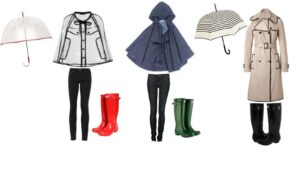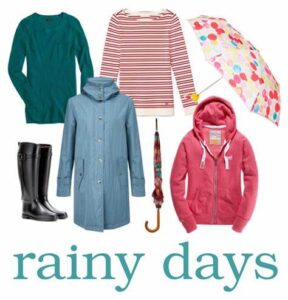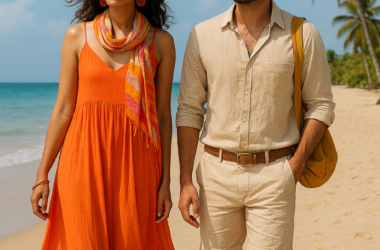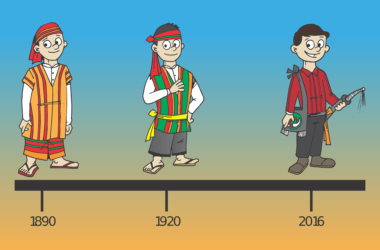As the world progresses, so does fashion, constantly evolving to match the needs and desires of society. One significant sector of fashion that has seen remarkable changes over the past few years is rainy fashionwear. The difference between 2024 and 2019 in terms of design, functionality, and sustainability of rainy fashionwear is profound, reflecting broader trends in technology, environmental awareness, and fashion innovation. This blog post delves into these differences, highlighting how rainy fashionwear has transformed from 2019 to 2024.
Technological Innovations and Functional Enhancements
The rainy fashionwear of 2024 is a testament to the significant strides made in wearable technology and functional design. In 2019, the focus was largely on basic functionality—raincoats, umbrellas, and waterproof boots that offered decent protection against the rain. However, these items often sacrificed style for utility and were generally not equipped with advanced features. Fast forward to 2024, and the scene is drastically different.
Today’s rainy fashionwear incorporates cutting-edge technology to enhance user experience. Smart fabrics that adjust their water resistance levels based on humidity and rainfall intensity have become standard. Many rain jackets now feature built-in heating elements powered by compact, rechargeable batteries to keep wearers warm during cold showers. Additionally, integrated LED lights have become popular, improving visibility in low-light, rainy conditions. These technological advancements ensure that rainy fashionwear is not only more comfortable and practical but also safer and more efficient.

Design and Aesthetic Evolution
The aesthetic appeal of rainy fashionwear has seen a significant overhaul from 2019 to 2024. In 2019, rainy fashion was often utilitarian, with limited color palettes and basic designs that prioritized function over form. The typical raincoat was plain, the umbrellas were mostly monochrome, and waterproof footwear was bulky and unappealing. The fashion industry was only beginning to experiment with more stylish rainy wear, and most options were still quite conservative.
In 2024, however, the integration of fashion and functionality has reached new heights. Rainy fashionwear now features vibrant colors, bold patterns, and sleek designs that allow individuals to express their style even in inclement weather. Designers have embraced materials like transparent PVC and reflective fabrics, creating visually striking pieces that also enhance visibility. High-fashion brands have also entered the rainy wear market, offering luxury rainwear that blends high performance with runway-ready aesthetics. This fusion of style and functionality means that today’s consumers no longer have to choose between looking good and staying dry.

Sustainability and Ethical Production
One of the most profound differences between rainy fashionwear in 2019 and 2024 is the shift towards sustainability and ethical production. In 2019, the fashion industry was becoming increasingly aware of its environmental impact, but sustainable practices were not yet mainstream. Many rainy fashion items were made from non-recyclable materials and produced in ways that were harmful to the environment.
By 2024, sustainability has become a core principle of fashion design and production, driven by both consumer demand and regulatory changes. Rainy fashionwear now prominently features eco-friendly materials such as recycled plastics and biodegradable fabrics. Brands are committed to transparent supply chains, ensuring that their products are ethically produced with fair labor practices. Additionally, the concept of circular fashion has gained traction, with brands offering take-back programs for old rainwear to be recycled or upcycled. This shift not only reduces the environmental footprint of rainy fashionwear but also appeals to a growing demographic of environmentally conscious consumers.

Conclusion
The transformation of rainy fashionwear from 2019 to 2024 highlights the broader trends of technological advancement, aesthetic innovation, and sustainability within the fashion industry. Modern rainwear is smarter, more stylish, and environmentally friendly, reflecting the evolving priorities of consumers and the fashion world. As technology continues to advance and societal values shift further towards sustainability, it will be exciting to see how rainy fashionwear and fashion, in general, continue to innovate and adapt in the years to come.
Utpal Khot
Copyright © Utpal K
1. If you share this post, please give due credit to the author Utpal Khot
2. Please DO NOT PLAGIARIZE. Please DO NOT Cut/Copy/Paste this post
© Utpal K., all rights reserved.
Copyright Notice: No part of this Blog may be reproduced or utilized in any form or by any means, electronic or mechanical including photocopying or by any information storage and retrieval system, without permission in writing from the Blog Author Utpal Khot who holds the copyright.





